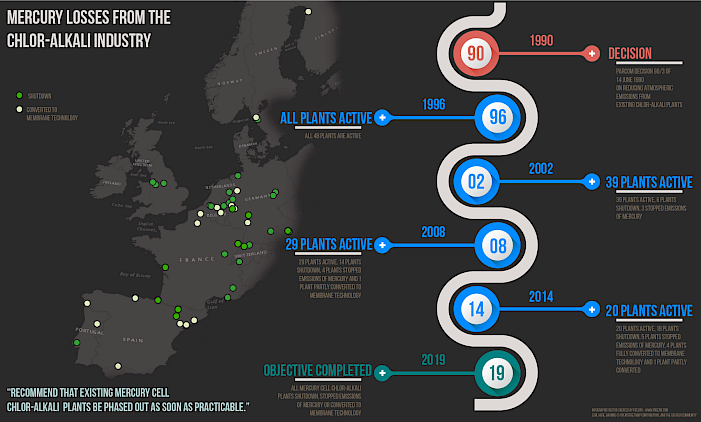OSPAR has completely phased out all mercury cell chlor-alkali plants in its Maritime Area
All mercury cell chlor-alkali plants in the OSPAR Maritime Area have been phased out completely as a result of its Contracting Parties fully implementing PARCOM Decision 90/3 on reducing atmospheric emissions from existing chlor-alkali plants.
The 2019 round of data reporting on discharges, emissions and losses of mercury by all routes from mercury-cell chlor-alkali plants operating within the OSPAR Maritime Area, revealed that chlor-alkali plants in the OSPAR Maritime Area no longer use mercury technology for the production of chlor-alkali. Therefore, these discharges, emissions and losses of mercury have ceased altogether.
History of the Decision
In 1983, Contracting Parties to the former Paris Convention initiated annual reporting on discharges, emissions and losses of mercury by all routes from mercury-cell chlor-alkali plants operating within the OSPAR Maritime Area. Annual data on production capacities, atmospheric emissions of mercury, and the amount of mercury in safely deposited wastes have been reported to the OSPAR Secretariat via EuroChlor which, following a check and validation by Contracting Parties, compiled the technical data to form the OSPAR chlor-alkali reports. This annual reporting of data and production of reports have assisted with the effectiveness of the implementation of PARCOM Decision 90/3.
In the intermediate years, the mercury-cell-based chlorine production capacities, mercury losses and atmospheric emissions of mercury have gradually decreased, primarily due to the partial or full conversion of plants to membrane technology and the closing down of plants.
Mercury emissions ceased in mid-2018 but some plants were noted as partly converted; these were confirmed by EuroChlor as being fully converted to membrane technology or shut-down and the 2019 reporting reflected the full cessation of mercury emissions from the chlor-alkali industry.
Click image for larger version

